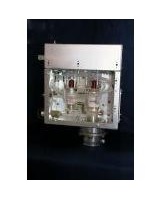Automatic Impedance Matching Network
63500-D Seligenstadt
14 Am Sandborn
+49 6182 96280
+49 6182 962816
Impedance matching networks (PRODIK series) - Power range: 300 W to 30 kW - Wide impedance range - Various circuits available for a wide variety of requirements (L, T, Pi, N) - Output currents up to 300 A for extremely low impedance
Anfrage an Anbieter senden
Automatic Impedance Matching Network (AIMN)
An Automatic Impedance Matching Network (AIMN) is a system designed to automatically adjust the impedance of a circuit to ensure maximum power transfer between components, particularly in RF (radio frequency) applications. Impedance matching is essential to optimize signal transmission and minimize losses or reflections in a wide range of devices like antennas, transmitters, receivers, and other RF components.Key Concepts
-
Impedance Matching:
- Impedance refers to the opposition a circuit presents to the flow of alternating current (AC) or RF signals. In RF circuits, impedance is often expressed as a complex value (resistance + reactance).
- Matching ensures that the impedance of the source (like a transmitter or RF signal generator) is equal to the impedance of the load (like an antenna or receiver). Mismatched impedance leads to signal reflections, power loss, and reduced efficiency.
-
Why is Impedance Matching Important?
- Maximizes Power Transfer: According to the Maximum Power Transfer Theorem, power is maximized when the impedance of the load matches the impedance of the source.
- Minimizes Signal Reflection: Impedance mismatch causes reflections, which can degrade signal quality, leading to poor performance and data loss.
- Improves Efficiency: Proper impedance matching ensures that the maximum amount of energy is transferred, enhancing the overall system performance.
-
Automatic Adjustment:
- Unlike manual impedance matching, which requires adjustments using components such as variable capacitors or inductors, an Automatic Impedance Matching Network can dynamically adjust the impedance using automated components like tunable capacitors, inductors, or switches.
- This dynamic adjustment is useful in systems where conditions may change rapidly (e.g., varying frequency, temperature, or environmental conditions).
Components of an Automatic Impedance Matching Network
-
Tunable Components:
- Tunable Capacitors: These components can change their capacitance value based on the applied voltage or control signal, allowing the impedance to be adjusted.
- Tunable Inductors: Inductors whose inductance can be adjusted to help balance impedance.
- Switches: Often used to select among different capacitors or inductors to create the optimal matching condition.
-
Feedback System:
- The automatic matching network uses a feedback loop to continuously monitor the impedance mismatch and make real-time adjustments.
- This feedback is often provided by a reflected power sensor or a VSWR (Voltage Standing Wave Ratio) meter, which measures the amount of power reflected due to impedance mismatch.
-
Control Circuitry:
- Microcontroller or DSP (Digital Signal Processor): The control unit processes data from the feedback system and adjusts the tunable components accordingly.
- The controller is responsible for setting the correct values for the components and can also communicate with external devices for real-time control.
Working Principle
- Measurement: The system continuously monitors the impedance of the load using a sensor (often a VSWR meter). The VSWR indicates how much power is reflected due to impedance mismatch.
- Impedance Calculation: Based on the measurements, the controller calculates the difference between the source impedance and load impedance.
- Adjustment: The network then adjusts the impedance using its tunable components (capacitors, inductors, or both) to match the load impedance to the source impedance.
- Continuous Operation: This process is continuous and dynamic, ensuring that the impedance is always matched despite environmental changes or fluctuations in frequency.
Applications of Automatic Impedance Matching Networks
-
Antenna Matching:
- Used to match the impedance of antennas with transmitters or receivers in communication systems (e.g., mobile networks, satellite communication). Antenna systems typically have a complex impedance that varies with frequency and other factors, requiring an adaptive matching network.
-
RF Power Amplifiers:
- In RF power amplifiers, automatic impedance matching ensures maximum power output and minimal reflection, which is crucial for maintaining signal integrity and efficiency.
-
Broadcasting:
- For radio and television transmission, AIMNs are used to ensure optimal power transfer between the transmitter and antenna system, minimizing loss and reflection of signals.
-
Satellite Communication:
- In satellite ground stations and satellite communication systems, impedance matching ensures that signals can be transmitted and received efficiently across long distances.
-
Medical Devices:
- In applications such as MRI machines or medical ultrasound equipment, impedance matching is essential for ensuring high-quality data transmission and reception.
-
Consumer Electronics:
- Automatic impedance matching networks are used in modern communication devices like smartphones, routers, and Wi-Fi systems to optimize performance.
Benefits of Automatic Impedance Matching
- Real-Time Adjustment: Provides continuous automatic adjustment of impedance to account for dynamic changes in environmental conditions or signal frequency.
- Enhanced Efficiency: Ensures maximum power transfer, improving overall system performance and reducing energy waste.
- Simplicity and Automation: Eliminates the need for manual impedance adjustments, making the system more reliable and reducing operator errors.
- Minimized Signal Loss: Reduces reflection losses by maintaining optimal impedance matching, leading to cleaner signals and higher-quality communication.
Conclusion
An Automatic Impedance Matching Network (AIMN) is a crucial component in modern RF systems. By continuously monitoring and adjusting the impedance, these systems ensure maximum power transfer, reduced signal loss, and optimized efficiency in a variety of applications, from telecommunications to medical devices. The ability to dynamically adjust impedance makes AIMNs indispensable in systems where conditions can change rapidly, helping to maintain consistent and reliable performance.Operating Pressure
Operating Temperatur
Nominal Size



